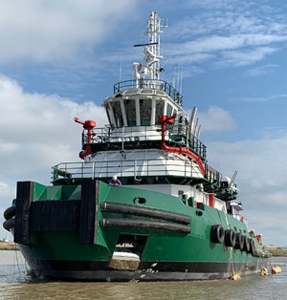Tugboat watchers along the Saint Lawrence Seaway between Massena, N.Y., and Lake Ontario will witness a changing of the guard during the 2020 shipping season.
The 118-foot Seaway Guardian — a massive, muscular and well-equipped icebreaking tug — will replace the venerable 61-year-old Robinson Bay. The new vessel will perform icebreaking and barge-handling duties in addition to tending aids to navigation on the United States’ 100-mile section of the 2,300-mile marine highway.
The Saint Lawrence Seaway Development Corporation (SLSDC) opened its 62nd navigation season April 1. The Seaway consists of 15 locks: 13 on the Canadian side of the border, and the Eisenhower and Snell Locks on the U.S. side.
The SLSDC chose Robert Allan Ltd. of Vancouver, British Columbia, to adapt its proven TundRA 3600 ice-class tug design for work on the St. Lawrence. Gulf Island Shipyards of Houma, La., built the vessel.
“Representatives from Robert Allan Ltd. recommended the TundRA 3600-class tug primarily because its hull provided the greatest flexibility in design to meet our requirements,” said Capt. Michael Howard, SLSDC’s executive officer.
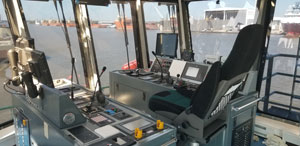 |
|
Simrad and Furuno navigation electronics populate Seaway Guardian’s wheelhouse. |
|
SLSDC |
Officials from the SLSDC and Robert Allan Ltd. toured Ocean Tundra, a TundRA 3600 ship-assist and tethered-escort tug operating for Ocean Group in Quebec. Seaway Guardian’s primary mission differs from the Canadian boat, but the tour gave SLSDC officials a better understanding of the size, layout and capabilities of the TundRA 3600 series.
Howard, as Robinson Bay’s captain, has headed out each spring and fall for the past seven years to commission and decommission buoys as the Seaway opens and closes the shipping season. “The tug’s primary mission is retrieving and deploying (navigation) aids in fall and spring,” he said. “This can be accomplished using the vessel by itself or by pushing the corporation’s buoy barge.”
The new tug, fitted with a push knee on the bow and a Markey Machinery towing winch on the stern, will be the prime mover of Grasse River, a 300-ton derrick crane barge employed for the most part lifting gates at the Snell and Eisenhower Locks. Having the ability to tow from the bow and stern is advantageous for tending barges on construction and repair projects. Firefighting, assisting grounded boats, hazardous spill response and ship assist during high water round out the tug’s mission.
“It is nice to have new assets for our area,” said Nate Jarvis, an SLSDC port engineer. “We will be able to do much more work and provide more services. And with the (ABS) FF-Capable classification, we have firefighting capability for the new tankers transiting the Seaway.”
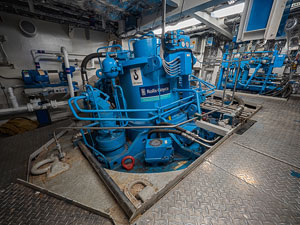 |
|
The propulsion package on Seaway Guardian consists of Kongsberg/Rolls-Royce z-drives, above, paired with twin 2,682-hp Caterpillar 3516 Tier 4 engines, below. |
|
Brian Gauvin |
Seaway Guardian, with 14 berths, spill response equipment and a workboat for deploying an oil-skimming boom, can serve as a mother ship and command center for emergency response operations. And with an ABS Ice Class A1 notation, it can break through 3 feet of ice at 3 knots.
Mounted on the starboard quarter of the stern deck is a powerful Rapp Marine HP40-40kE knuckle-boom deck crane. When extended to its maximum reach of 40 feet, it boasts a lifting load capacity of 19,700 pounds.
The crane, by and large employed in buoy tending, rises over an OSV-style aft deck lined with wood planks and side rails. The aft deck is fitted with a Markey tugger winch, a Schoellhorn-Albrecht capstan, Smith Berger shark jaws and a Smith Berger stern roller.
In line with the robust design of Seaway Guardian, the brawny Markey TES-34UL electric towing winch is housed in an enclosed compartment for protection against the elements. The winch is wound with 1,000 feet of 2-inch cable. “This will primarily be used for towing, but could be used as a backup for buoy tending,” Howard said.
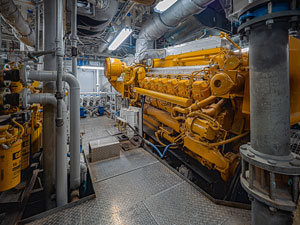 |
|
Brian Gauvin |
The stern equipment supports the tug’s essential role as a buoy tender, but the variety and configuration lends itself well to marine construction projects. “We can do construction — with less equipment and barges — right off the stern,” Jarvis said.
Two Patterson deck winches and another Schoellhorn-Albrecht capstan are installed on the fore deck. The push knees, lined with M-type fendering on the bow, facilitate a model-bow barge makeup. The port and starboard quarters have two bands of D-type rubber followed by tires amidships. Schuyler Companies fabricated the fendering.
The equipment aboard Seaway Guardian is rated to withstand the notoriously cold, ice-bound winter conditions experienced on the Saint Lawrence River. The decks feature a heat tracing system to reduce ice accumulation and improve crew safety while working on deck.
In the engine room, two 2,682-hp Caterpillar 3516E Tier 4 main engines are mounted, port and starboard, next to the hull. Each engine is shafted to Kongsberg/Rolls-Royce US 35 CP azimuthing z-drive units. The Cat mains employ an SCR aftertreatment system to meet Tier 4 emissions standards.
Two Fire Fighting System (FFS) fire pumps, shafted to the front of the main engines through a power takeoff, pump up to 5,280 gpm of water to FFS monitors mounted forward of the pilothouse. The two Caterpillar C9.3 250-kW generators are mounted between the mains along the centerline. A 150-kW Caterpillar C7.1 harbor genset is installed on the port side, forward of the mains.
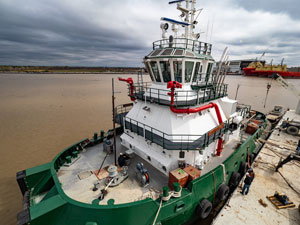 |
|
Seaway Guardian’s robust deck equipment package consists of Patterson barge winches, Markey winches and a Rapp Marine knuckle-boom crane. |
|
Brian Gauvin |
Mike Phillips, project manager for Robert Allan Ltd., said the propulsion machinery is smaller than on Ocean Group tugs, owing to their different roles. However, Seaway Guardian will still generate a hefty 65 tons of bollard pull.
Another design departure from Ocean Tundra is the addition of an extra tier of deckhouse below the pilothouse. The addition increased the berthing from 10 to 14, accommodating the extra crew employed during the extended spring and fall buoy-handling operations. Seaway Guardian will typically have a complement of four to six crew.
Bunks in each cabin are located inboard to separate them from the cold exterior bulkheads, and to minimize the motion experienced by crewmembers when resting. The galley, generous mess area, and the captain and chief engineer’s cabins are on the main deck.
“The second level of accommodation also helps to set the wheelhouse high for an improved view when pushing the buoy barge and (towing) the gate lifter barges,” Phillips said.
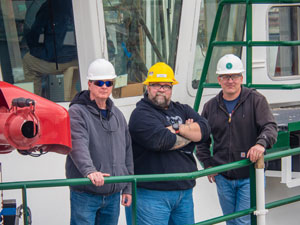 |
|
SLSDC employees (from left) Capt. Rick Randal, port engineer Nate Jarvis and Capt. Michael Howard oversaw construction at Gulf Island Shipyards. The COVID-19 pandemic has delayed sea trials and pushed back delivery. |
|
Brian Gauvin |
The wheelhouse has a split-level design with massive aft windows spanning the two levels. The forward and beam windows are generous in area, providing excellent all-around visibility. The split-level parallel forward control station further improves the helmsman’s fore and aft visibility.
In January 2020, the SLSDC made another leap when it ordered HT-60, a 60-foot z-drive harbor tug from Washburn & Doughty of East Boothbay, Maine. Although the smallest in the Harbor Tug series developed by Glosten, the tug’s broad bow — with a semi-raised foc’sle deck and generous visibility — offers operating advantages when working in tight lock chambers. Delivery is scheduled for 2021.
“During the winter months, she will assist with icebreaking and ice management around the locks,” said Howard. “This vessel will also have an ice scraper specifically designed to attach to either the port or starboard quarter and will allow the vessel to scrape ice off the lock wall.”
In the meantime, Seaway Guardian represents a six-decade leap in design, materials and technology for the SLSDC. But, lest we forget Robinson Bay, which now moves into a backup role with the agency for the foreseeable future.

